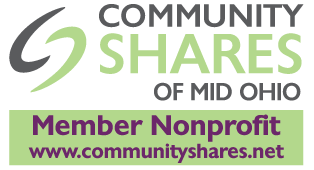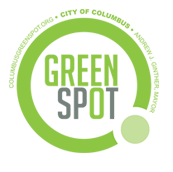City of Columbus Department of Public Service Engineers:
- Bud Braughton, Downtown and Special Projects, Division of Design and Construction
- Daniel Moorhead, Division of Infrastructure Management
- Steve Wasosky, Design Section Manager, Division of Design and Construction
- Richard Ortman, Project Manager and Bridge Engineer, Division of Design and Construction (NOT PICTURED)
“How can we continue to improve and take the next step to make Columbus one of the top biking cities in the nation?”
Under Mayor Michael B. Coleman’s leadership, the Columbus Department of Public Service in October 2014 escalated its commitment to supporting bicyclists and enhancing the city’s bike infrastructure. At that time, Public Service Director Tracie Davies reached out to Yay Bikes! for a meeting with City staff. With maps of the city splayed over their tables, they asked us “How can we improve and take the next step in making Columbus one of the top biking cities in the nation? They wanted feedback from real, everyday bicyclists. Our response: let’s ride!
“I need to experience it.”
A few weeks after that meeting, engineers Bud Braughton, Richard Ortman, and Daniel Moorhead, each with a different infrastructure specialization—downtown and Ohio Department of Transportation projects, bridges, and bikes respectively—found themselves riding the roads with representatives from Yay Bikes!. “I want to use good engineering judgment and keep it safe for everyone, so I need to be back on a bike and experience it,” Bud said.
Each engineer had his own previous experience with bicycling. Bud hadn’t ridden much since his teenage years when he cruised through his neighborhood on the west side before gaining his driver’s license and “freedom.” Richard biked sometimes for recreation and even to work on occasion, using the Olentangy bike path. Daniel was a seasoned bicyclist, having picked it up when he was hired by the Department of Public Service as a bike transportation engineer.
Despite different levels of comfort and experience, most of the engineers were apprehensive of this approach. None of them expected the results that came out of the initial ride. They each vividly recall that first experience riding with Yay Bikes!.
“Because I like to ride on bike paths, I typically would not ride alone on downtown streets,” says Richard. “I had some trepidation, but I never turn down a learning opportunity.”
“Yay Bikes! gave us a whole new perspective.”
“It was a lot different than we expected,” Bud said. “As engineers, we’re focused on making it work, but Yay Bikes! gave us input from a customer perspective.” This feedback has helped the engineers and their team grow in their understanding of needs for bike infrastructure and how it related to the details of their ongoing projects.
“It was nice to have Yay Bikes! share their concerns, which factor into our decisions,” Bud said. The collaboration yielded a first for Columbus. “One of those decisions was to add protected bike lanes to our roads,” Richard said. “You’ve [Yay Bikes!] enhanced our previous understanding of the danger of a door zone and the need for a buffer,” Richard added. “It’s good to see what works well in Columbus.”
“Biking is important.”
The success from their relationship with Yay Bikes! has translated to a more collaborative working environment and a bike-centric office culture. “This is the next step in the evolution of meeting Mayor’s goal of making this one of the top biking cities in the nation,” Daniel said. “The department and Yay Bikes! are part of a culture shift in Columbus. It’s really refreshing.”
The engineers now ride city streets at least monthly to check in on their projects. Representatives from the Columbus Recreation and Parks Department and the Columbus Public Health Department often join them to offer input on projects in the planning phase. And each has incorporated more bike trips into their non-work lives as well. “We just want our projects to be the best they can be for all users,” Bud said.
Looking to the future: bike design involvement is growing
You can see the evolution, the culture shift, all around Columbus. Since the City implemented its Bikeways Plan in 2008, investments in bicycle infrastructure have blossomed. The City has installed 34 miles of bike lanes, 2,400 sharrows on 60 miles of streets, constructed 11.6 miles of shared use paths, installed 320 Share the Road signs, 460 bike racks and 23 queue boxes. The City has also introduced the CoGo bike share program, with 390 bikes at 41 bicycle stations across the city.
In an effort to accelerate the addition of bike facilities and their delivery time, the Department of Public Service Design Section has begun generating plans for new bike facilities in-house. This allows for ideas to be implemented much more quickly and provides better oversight of consistent standards being used throughout the City. It is an exciting time. On-street bike facilities are an evolving part of roadway design, and new ideas are being implemented in Columbus and across the country. That’s why it is critical to make these facilities safe and understandable to all right of way users. Department of Public Service Design Section Manager Steve Wasosky joined the Engineer rides in the Spring of 2015.
“Riding these locations has been an essential tool to see conflicts and concerns that may not have been noticed when looking at only a two-dimensional plan view on paper,” Steve said. “Most of us already have a perspective on driving the roadway and the many concerns, but having the biking perspective on the same corridors dramatically helps the design provide a safer more user friendly ride,” Steve said.






